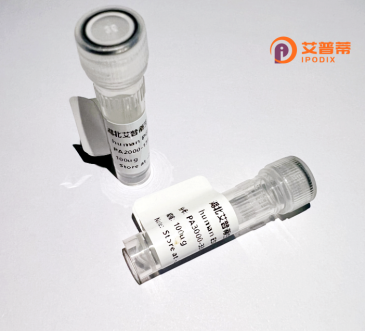
| 纯度 | >90%SDS-PAGE. |
| 种属 | Human |
| 靶点 | MIR16 |
| Uniprot No | Q9NZC3 |
| 内毒素 | < 0.01EU/μg |
| 表达宿主 | E.coli |
| 表达区间 | 1-331 aa |
| 活性数据 | MWLWEDQGGLLGPFSFLLLVLLLVTRSPVNACLLTGSLFVLLRVFSFEPVPSCRALQVLKPRDRISAIAHRGGSHDAPENTLAAIRQAAKNGATGVELDIEFTSDGIPVLMHDNTVDRTTDGTGRLCDLTFEQIRKLNPAANHRLRNDFPDEKIPTLREAVAECLNHNLTIFFDVKGHAHKATEALKKMYMEFPQLYNNSVVCSFLPEVIYKMRQTDRDVITALTHRPWSLSHTGDGKPRYDTFWKHFIFVMMDILLDWSMHNILWYLCGISAFLMQKDFVSPAYLKKWSAKGIQVVGWTVNTFDEKSYYESHLGSSYITDSMVEDCEPHF |
| 分子量 | 64.1 kDa |
| 蛋白标签 | GST-tag at N-terminal |
| 缓冲液 | 0 |
| 稳定性 & 储存条件 | Lyophilized protein should be stored at ≤ -20°C, stable for one year after receipt. Reconstituted protein solution can be stored at 2-8°C for 2-7 days. Aliquots of reconstituted samples are stable at ≤ -20°C for 3 months. |
| 复溶 | Always centrifuge tubes before opening.Do not mix by vortex or pipetting. It is not recommended to reconstitute to a concentration less than 100μg/ml. Dissolve the lyophilized protein in distilled water. Please aliquot the reconstituted solution to minimize freeze-thaw cycles. |
以下是可能的参考文献,但需注意miR-16通常指非编码RNA,而非蛋白质。相关研究可能涉及重组载体传递或与蛋白质相互作用:
1. **"Recombinant adenovirus-mediated miR-16 delivery induces apoptosis in breast cancer cells"**
- 作者:Liu Y, et al.
- 摘要:构建重组腺病毒载体过表达miR-16.证实其通过抑制BCL2蛋白促进乳腺癌细胞凋亡。
2. **"A novel recombinant protein carrier for efficient miR-16 delivery in chronic lymphocytic leukemia therapy"**
- 作者:Smith R, et al.
- 摘要:开发一种重组融合蛋白载体,有效递送miR-16至B细胞,显著降低癌细胞存活率。
3. **"Co-delivery of miR-16 and TRAIL recombinant protein enhances antitumor efficacy in lung cancer"**
- 作者:Chen X, et al.
- 摘要:利用重组质粒共表达miR-16和TRAIL蛋白,联合诱导肿瘤细胞凋亡,抑制小鼠模型肿瘤生长。
**注意**:miR-16属于microRNA家族,主要通过调控靶基因发挥作用,而非直接作为蛋白质产物。若您需miRNA相关递送技术或与蛋白质相互作用的研究,上述文献方向适用。若有其他需求,建议补充说明背景以更精准检索。
**Background of Recombinant Human MIR16 Protein**
Recombinant human MIR16 (MicroRNA-16-associated) protein is a engineered protein linked to the function of microRNA-16 (miR-16), a small non-coding RNA known for its role in regulating gene expression. miR-16 is involved in critical cellular processes, including apoptosis, cell cycle regulation, and differentiation, and has been implicated in diseases such as cancer, where it often acts as a tumor suppressor by targeting oncogenes like BCL2 and CCND1.
The recombinant MIR16 protein is typically produced using biotechnological systems (e.g., *E. coli* or mammalian cell cultures) to enable large-scale, pure yields for research and therapeutic applications. It may serve as a tool to study miR-16-related pathways or to develop miR-16-based therapies, such as mimicking its tumor-suppressive effects in cancers with miR-16 downregulation. Additionally, studies suggest its potential in modulating inflammation and autoimmune disorders due to miR-16's influence on immune cell function.
Current research focuses on optimizing delivery mechanisms (e.g., nanoparticles or exosomes) to enhance the protein's stability and tissue targeting. Despite challenges in specificity and off-target effects, recombinant MIR16 protein represents a promising avenue for advancing RNA-protein interaction studies and precision medicine. Further exploration is needed to fully elucidate its therapeutic scope and mechanistic details.
(Word count: 199)
×